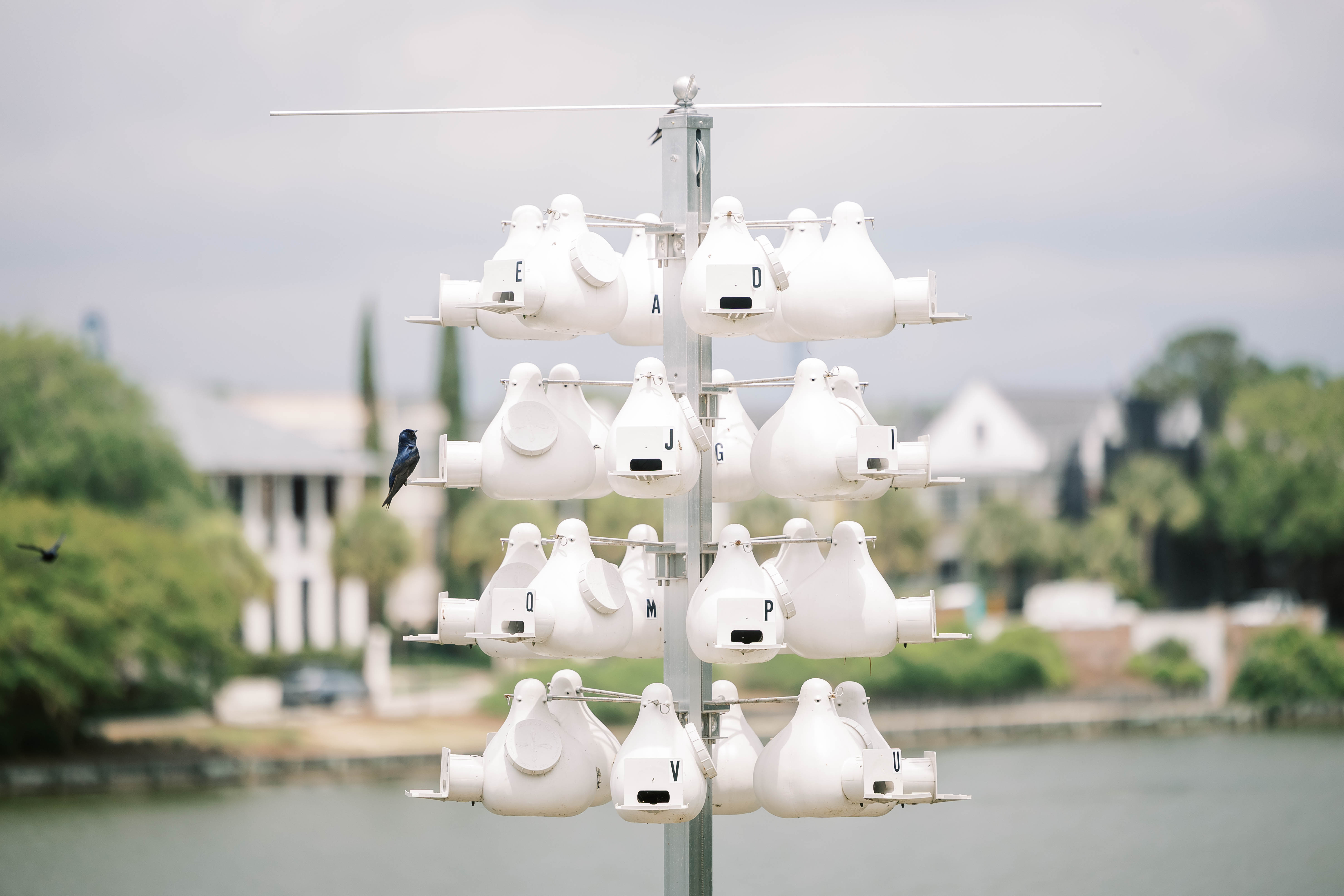Thank You Charlie Miller
Contributing to Our Community in the Most Interesting Way

In 2024, the I’On HOA approved a request to place a gourd rack on East Lake. Those residents who regularly walk the East Lake path near Grace Lane have probably learned by now, that the 24 white plastic gourds hanging on the 14 foot aluminum pole, are there to attract purple martins. But, some may not know why purple matins are desirable for our neighborhood.
Purple martins are communal birds who like being near humans. They are the largest member of the swallow family. The male is black all over, but in certain light the feathers have a dark purple sheen. The female is slightly smaller, black on the back with a light gray breast. Their pleasant chatter and graceful flight make them interesting neighbors. They also feed exclusively on flying insects, including flies, moths, beetles, mosquitos, termites, and midges. They only land on the ground when gathering materials for their nest. They are visitors who spend roughly half of their time in North America and the other half in Brazil. Each year the martins begin migrating to North America in January and begin their return to Brazil in July. East of the Mississippi River, their range is from Florida to Canada. Purple martins like living near humans. Hundreds of years ago, purple martins were nurtured by Native Americans who enticed them to nest in gourds hung on wooden poles near their villages and crop fields.
Since that time, our eastern subspecies of purple martin has become dependent on humans to furnish gourds or wooden bird houses for their nests. Smaller numbers of two western subspecies of the purple martin nest in cavities in trees and Saguaro cactus in the southwest USA and in California. These birds do not seek housing supplied by humans.
The gourd rack on East Lake was built by Troyer, a company in Conneautville, Pa, and incorporates many new design features that extend useful life of the equipment and protects the purple martins from predators. Many years ago a favorite purple martin housing was the natural gourd that was simply hollowed out with a round hole in the side. Natural gourds were subject to rot and had to be replaced every other year. Wooden houses with multiple compartments were also popular. An aluminum bird house, developed by Trio-Musselman in the early 1960’s, was popular, but the nest compartments were small compared to standards of today. Development of the plastic gourd in the 1990’s extended useful housing life to 10-20 years. Originally, all housing was built with a round hole, but that proved to be a problem. A non-native bird, the starling, competes aggressively for nesting sites and is a serious threat
to the purple martin. Starlings were first introduced into Central Park in New York in 1899 and have spread across the USA. They will enter a nesting cavity and kill the purple martin with their sharp beak. A major improvement was made when it was found that changing the round entrance hole to a narrow horizontal hole would exclude the starling. The purple martin easily flattens its body to enter, but starlings, which have a larger/upright breast profile, cannot enter. The entrance to the gourd was also lengthened to create a tunnel shape, so that owls could not reach their claw into the nest. A special baffle is attached around the base of the pole to prevent snakes and raccoons from reaching the nests. Troyer also improved the strength of the pole, by changing from a round 2 inch pipe to extruded 3 inch square aluminum. The entire rack supporting the gourds can be lowered to ground level for nest checks and cleaning. The purple martins tolerate opening a large screw–on cap on the side of the gourd to gain access to the nest. They do not mind having their eggs or babies touched by humans. Some caretakers
keep records on the number of eggs and hatched babies in each gourd.
Developing a colony of purple martins takes patience. There are 24 gourds on our rack, but we don’t expect all to be occupied immediately. In the 2024 season only one adult pair and one juvenile pair made nests. The adult pair fledged 3 birds. The younger pair did not seem to know what they were doing. They laid 2 eggs in two separate gourds, but no eggs hatched. So far, in 2025, there were 4 adult pairs nesting in early April and q few more expected by May. The martins begin building nests in April and soon lay 4-6 eggs which take 2 weeks to hatch. The babies are able to fledge after 4 weeks, and can immediately fly almost as well as mature birds. All the birds leave by about July 8 and congregate with tens of thousands of other birds in certain locations before they head to Brazil in August. One collection area is Bomb Island in Lake Murray, SC. Many bird enthusiasts take boat tours to observe the huge flocks. When the martins begin the flight to Brazil, they may fly 200-250 miles per day over land. Some take the long route through Mexico and Central America. Others take the 500-600 mile route directly
across the Gulf of Mexico without stopping. Most birds return each year to the same nesting site used the year before. We hope that the number of pairs will increase each year until all 24 gourds are filled.
Charles Miller